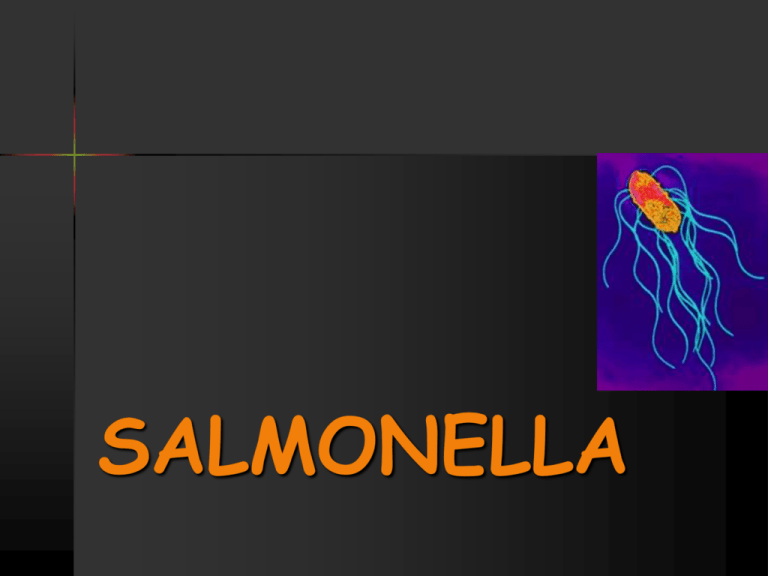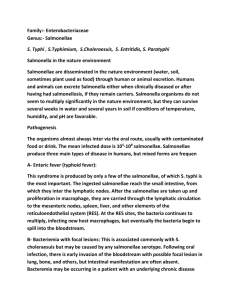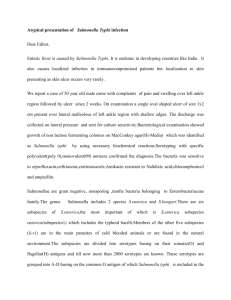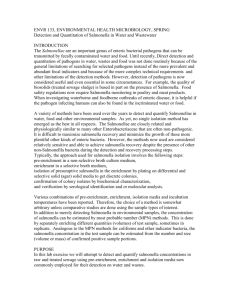SALMONELLA
advertisement

SALMONELLA Salmonella is a Gram-negative facultative rodshaped bacterium belonging to family Enterobacteriaceae, Salmonellae live in the intestinal tracts of warm and In humans, Salmonella are the cause of two diseases called salmonellosis: cold blooded animals. Some species are ubiquitous. Other species are specifically adapted to a particular host. – enteric fever (typhoid), resulting from bacterial invasion of the bloodstream, and – acute gastroenteritis, resulting from a foodborne infection/intoxication. Classification The taxonomy of the salmonellae has been in flux for many years, and it is problematic, with more than 2463 serotypes. Under the current American CDC (Center for Disease Control) classification scheme there are two species: Salmonella enterica and Salmonella bongori. S. enterica is further divided into 6 subspecies. Earlier classification system included – (1) the Kaufmanns-White system, which identified each serotype as an individual Salmonella species, – (2) the Edwards-Ewing system, which divided the salmonellae into 3 species (S. choleraesuis, S. enteritidis, and S. typhi) and hundred of serotypes, and – (3) a DNA hybridization scheme that lumped the salmonelae into two species known as S. enteritidis and S. bongori. S. enteritidis is then subdivided this species into the subspecies arizonae, diarizonae, enterica, houtanae, indica and salamae. S. enterica contains more than 2500 serotypes (2541 in l 2004) differentiated on the O and H- Antigens Salmonella Salmonella Salmonella Salmonella Salmonella serotype serotype serotype serotype serotype (serovar) Typhimurium, Enteritidis, Typhi, Paratyphi, Cholerae suis etc. Ex.: Salmonella enterica subspecies enterica serovar Typhi or Salmonella Typhi Although the classification of salmonellae relies primarily on serotyping of surface antigens, the typhi serotype can be differentiated from other serotypes on the basis of its relatively inert biochemical behavior. The typhi serotype is negative for Simmons citrate, gas from glucose, acetate utilization, etc. Morphology Gram – negative rods uncapsulated (except S. typhi) unsporulatedsporulaţi Peritrichous flagella (ensure motility) Cultural properties Aerobe-anaerobe facultative Grow easily on simple culture media Onto selective and differential media that contain biliary salts and lactose grow like lactose-negative “S” colonies. produce de H2S, colonies have a “cateye” appearance. Biochemical properties Motile, Lactose negative; acid and gas from glucose, mannitol, maltose, and sorbitol; no Acid from adonitol, sucrose, salicin, lactose ONPG test negative (lactose negative) Indole test negative Methyl red test positive Voges-Proskauer test negative Citrate positive (growth on Simmon's citrate agar) Lysine decarboxylase positive Urease negative Ornithine decarboxylase positive 2S produced from thiosulfate Phenylalanine and tryptophan deaminase negative Gelatin hydrolysis negative TSI (Triple Sugar Iron) MIU (Motility Indole Urea). Simmons Citrate medium Mechanisms of Pathogenicity (1) Bacterial products involved in virulence: Salmonellae owe their pathogenicity largely to their ability to invade tissue and to survive within macrophages. The Vi antigen is a capsule that affords salmonellae some protection from phagocytosis. Once phagocytosed, S. typhi inhibits generation of oxidative free radicals and intraphagosomal killing. Additionally, salmonellae have endotoxic lipopolysaccharide, which is responsible for septic shock in patients with bacteriemia. Salmonellae that cause enteritis produce at least two enterotoxins that are responsible for many of the clinical signs of enteritis. The first of these is a small (25-30kD) protein that binds to GM1 gangliosides and cause hypersecretion of fluids and electrolytes by elevating levels of c AMP. It appears that both proteinkinase C and prostaglandin E2 are involved in this process. The second enterotoxin is larger (about 100 kD) and is unrelated in structure and mechanism of activity to the first enterotoxin Salmonella strains that produce enterotoxins have been reported to invade the intestinal wall more effectively and to be more virulent than their nontoxigenic counterparts. (2) The Salmonella infection cycle. Intestinal infection with salmonellae can follow one of two infection cycle. One cycle causes enteritis, other causes typhoid (a) Enteritis. Most serotypes cause enteritis, an infection that is limited to the terminal ileum. The salmonellae invade the intestinal wall and produce enterotoxins that cause nausea, vomiting and diarrhea. Bacteria rarely spread beyond the gastrointestinal wall. (b) Enteric fever (Typhoid). Two serotypes typhi and paratyphi can cause typhoid. The salmonella invade the wall of the terminal ileum and than spread to the intestinal lymphatics, where they are phagocytosed by PMNs and macrophages. Salmonella phagocytosed by PMNs are killed, but those phagocytosed by macrophages survive and multiply within phagocytic vacuoles. Wandering macrophages that contain salmonellae act as “taxicabs” that deliver salmonellae to various reticuloendothelial tissues. Infected macrophages are eventually destroyed and salmonellae released from lysed macrophages cause septicemia. Some salmonellae begin to disseminate hematogenously to a variety of ectopic sites, including the bones, lungs, liver, brain where they cause osteomyelitis, pyelonephritis, empyema, hepatic necrosis, meningitis. Other salmonella remain in the intestine, where they invade the gut wall and may cause ulceration, perforation and hemorrhage. Salmonellae multiply avidly in the gallbladder and bile, and the infected bile continues to circulate salmonellae to the intestine. Salmonellae also multiply well in gut associated lymphoid tissue and may ulcerate Payer’s patches Epidemiology: In many countries Salmonella enteritis is the third most commonly reported form of “food poisoning”. The infection is zoonotic, and the poultry is the source of infection. Other sources of infection include milk products, food and water contaminated with animal feces or urine (1) Enteritis 8-48 hours after the ingestion of food or drink contaminated with Salmonella, enterocolitis begins with nausea, vomiting, abdominal pain, diarrhea which can vary from mild to severe. In some cases manifestation include fever, headache and chills. Salmonella enteritis last about 5 days, but severe loss of fluids and electrolytes may be lifethreatening in infants and elderly patients. Recovery from enteritis does not confer immunity against reinfection (2) Enteric fever (typhoid) About 7-14 days after ingesting salmonellae, patients begin to develop symptoms and signs of typhoid, including – anorexia, – lethargy, – a dull frontal headache, – a nonproductive cough, – abdominal pain, – fever up to 40 C, At this time, there are no salmonellae detected in the blood, and leukocyte count is normal. By the second or third week of disease, salmonellae have escaped macrophages and the patient is severely ill. Rose spots may appear on the trunk and they contain salmonellae. In some cases, patients suffer from delirium. If peyer pathes become perforated, peritonitis may develop. Dissemination of salmonellae in ectopic foci may result in liver necrosis, empyema, meningitis, osteomyelitis, endocarditis. The fatality rate is 2-10% Recovery is a prolonged process, that last for a month or longer, and it confers a lifelong immunity against typhoid. (3) Primary septicemia Patients with anemia may develop septicemia after asymptomatic ileal infection with S. choleraesius. Manifestation include spiking fever, weight loss, anorexia, anemia, bacteriemia, bacteremia, hepatosplenomegaly. Diagnosis The diagnosis of salmonellosis requires bacteriologic isolation of the organisms from appropriate clinical specimens. Laboratory identification of the genus Salmonella is done by biochemical tests; the serologic type is confirmed by serologic testing. Feces, blood, or other specimens should be plated on several nonselective and selective agar media (blood, MacConkey, eosin-methylene blue, bismuth sulfite, Salmonella-Shigella, Hektoen agars) as well as intoenrichment broth such as selenite or tetrathionate. The biochemical reactions of suspicious colonies are then determined on triple sugar iron agar and lysine-iron agar, and a presumptive identification is made. Biochemical identification of salmonellae has been simplified by systems that permit the rapid testing of 10-20 different biochemical parameters simultaneously. The presumptive biochemical identification of Salmonella then can be confirmed by antigenic analysis of O and H antigens using polyvalent and specific antisera. Salmonella isolates then should be sent to a central or reference laboratory for more comprehensive serologic testing and confirmation.








